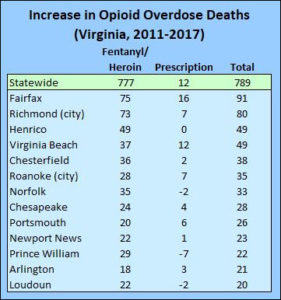
Everyone seems to agree that Virginia, like the rest of the nation, is in the grips of an epidemic of opioid overdoses. Virginia Department of Health (VDH) data show that the number of overdose deaths attributable to Fentanyl and/or heroin and to prescription opioids has increased from 637 in 2011 to 1,426 last year. The dominant trope in reporting and commentary on this surge is to refer to it as a “disease of despair” connected to deteriorating social and economic conditions. To add insight, VDH breaks down not only the number of overdoses by locality on its data portal, but so-called “social determinants of health” such as the percentage of children in poverty.
“On the surface, it appears to be the opioid epidemic, but where you look at the opioid epidemic or addiction in general, it’s really a disease of despair,” said State Health Commissioner M. Norman Oliver at a Virginia Board of Health meeting last month. “What drives it is the lack of jobs, the lack of affordable housing, the lack of transportation …”
When the opioid epidemic first attracted media attention a few years ago, the disease-of-despair label seemed to make sense. While overdoses were more frequent as measured by absolute numbers in Virginia’s metropolitan areas, as a percentage of the population, overdoses were higher in many rural counties — particularly in poor Appalachian counties — Tazewell, Russell, Washington, and Dickenson most prominently — where the traditional coal mining/mill town economy was disintegrating.
We’ve all heard the narrative. Poor, hopeless, rural Virginians would get hooked on prescription pain killers. When they couldn’t get prescription drugs, they moved on to heroin. Next thing you know, the heroin was laced with Fentanyl and addicts began dropping like flies. Meanwhile, drug overdoses went hand-in-hand with an increase in suicides and other self-destructive behavior.
I’m not suggesting from my cursory examination of the data that the conventional wisdom is wrong. But I would suggest that the story is more complicated — as Oliver acknowledged during the last month’s VHB meeting. “What we’re dealing with is an addiction epidemic, not an opioid epidemic,” he said. “We may get a handle on prescription opioids just to see meth and other things take their place.”
Indeed, it appears that the alarm over prescription opioids is having a dampening effect. The surge of opioid-related overdoses between 2011 and 2017 was driven almost entirely by Fentanyl and heroin. The number of prescription-related deaths increased by only 12 over that six-year period. The devastating increase in overdose deaths resulted mainly from the introduction of the super-powerful Fentanyl into the illegal drug marketplace. Fentanyl/heroin overdose deaths increased by 777 over the same period.
However, statewide averages obscure what’s happening at the local level, and local trends diverged remarkably. The number of drug overdoses actually declined in 24 localities over the six years covered in the VDH database. Every one of those localities (except one small city, Buena Vista) was a poor, rural county in Southside, Southwest or Western Virginia. The most marked drops occurred in the “despair-central” counties of Tazewell, Russell, Washington, and Dickenson.
Another 20 Virginia jurisdictions showed no change. Other than the small cities of Staunton and Williamsburg, all were predominantly rural counties.
Where, then, did the surge in overdoses occur? Check the table atop this post. In raw numbers, Fairfax County, Richmond, Henrico County and Virginia Beach topped the list. The increase in Richmond was particularly striking, given its smaller population than other jurisdictions atop the list. One cannot help but wonder if the growing number of deaths in neighboring Henrico and Chesterfield is related. Both counties have seen an influx of poor households from the city in recent decades.
The localities in the table are not seeing a commensurate surge in prescription overdoses, which suggests that the overdose epidemic stems from some other cause than the painkiller-to-heroin-to-Fentanyl pathway. An alternate theory: The introduction of Fentanyl is primarily affecting populations where heroin addiction has long been a deeply rooted problem.
It is worth noting that the localities seeing the biggest increases are not economic backwaters. They are in prosperous metropolitan areas. Deaths of despair? Are overdose victims people in poor neighborhoods who couldn’t find mass transit connections to jobs? I’m dubious. In my observation, drug and alcohol addiction strikes all levels of society indiscriminately.
Some people are inclined to blame all of society’s ills on one form of inequality or another. I tend to think the story is a lot more complicated. One way or another, the subject warrants a deeper dive than I manage in a morning’s work on this blog.

Leave a Reply
You must be logged in to post a comment.